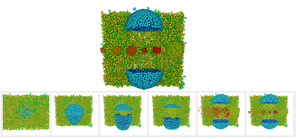Information
- Publication Type: Bachelor Thesis
- Workgroup(s)/Project(s):
- Date: August 2017
- Date (Start): 2. September 2016
- Date (End): 22. August 2017
- Matrikelnummer: 1392020
- First Supervisor: Johannes Sorger
Abstract
In bio-molecular visualizations animations are used to convey transitions between different representation states. For example, to understand the transition from a physical correct representation of a HIV molecule to an abstract visualization like a bar chart, an animation can be used. This method allows to trace the structures during the transition and therefore brings them into a direct relation. The disadvantage of an animation is that the presented content is fleeting. Therefore, the change over time cannot be compared or investigated in detail. To mitigate this disadvantage, we propose a hybrid visualization composed of an animation and a series of still images. The series of still images allows an overview over the transition and comparison of states, but the relation of the representations may get lost. For this reason, the animation is used. By clicking on a single frame inside the sequence the animation is played starting from the selected frame to the next frame in the sequence. The expressiveness of the narrative sequence of images is determined by the selected images. Therefore, we adapted Key Probe, an object based key frame extraction method developed by Huang et al., to be operable on molecular data. Molecular data consists of thousands of protein instances and is therefore challenging for object based key frame extraction methods. We introduced several optimization techniques to Key Probe. We show that the adapted Key Probe returns reasonable result within a reasonable computation time. The so extracted key frames are then displayed in a sequence of images together with a 3D animated view of the molecular data. This allows, additionally to the fast overview, an in-depth exploration of a specific sub-sequence of the animation.Additional Files and Images
Weblinks
No further information available.BibTeX
@bachelorsthesis{stappen_2017_animatedcomic,
title = "Hybrid Frames - Animated Narrative Sequences in Molecular
Visualization",
author = "Stefan Stappen",
year = "2017",
abstract = "In bio-molecular visualizations animations are used to
convey transitions between different representation states.
For example, to understand the transition from a physical
correct representation of a HIV molecule to an abstract
visualization like a bar chart, an animation can be used.
This method allows to trace the structures during the
transition and therefore brings them into a direct relation.
The disadvantage of an animation is that the presented
content is fleeting. Therefore, the change over time cannot
be compared or investigated in detail. To mitigate this
disadvantage, we propose a hybrid visualization composed of
an animation and a series of still images. The series of
still images allows an overview over the transition and
comparison of states, but the relation of the
representations may get lost. For this reason, the animation
is used. By clicking on a single frame inside the sequence
the animation is played starting from the selected frame to
the next frame in the sequence. The expressiveness of the
narrative sequence of images is determined by the selected
images. Therefore, we adapted Key Probe, an object based key
frame extraction method developed by Huang et al., to be
operable on molecular data. Molecular data consists of
thousands of protein instances and is therefore challenging
for object based key frame extraction methods. We introduced
several optimization techniques to Key Probe. We show that
the adapted Key Probe returns reasonable result within a
reasonable computation time. The so extracted key frames are
then displayed in a sequence of images together with a 3D
animated view of the molecular data. This allows,
additionally to the fast overview, an in-depth exploration
of a specific sub-sequence of the animation.",
month = aug,
address = "Favoritenstrasse 9-11/E193-02, A-1040 Vienna, Austria",
school = "Institute of Computer Graphics and Algorithms, Vienna
University of Technology ",
URL = "https://www.cg.tuwien.ac.at/research/publications/2017/stappen_2017_animatedcomic/",
}

 teaser
teaser thesis
thesis
